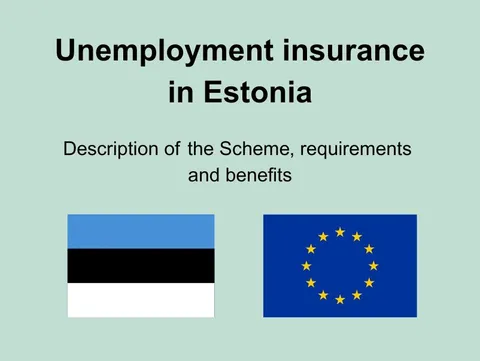EU
Estonia
Unemployment
Insurance
Unemployment Insurance in EU->Estonia
Unemployment insurance in Estonia
This article covers what you need to know about claiming unemployment insurance benefit (töötuskindlustushüvitis) and unemployment allowance (töötutoetus) in Estonia.
In what situation can I claim?
You can claim unemployment insurance benefit if you are unemployed and meet the eligibility requirements:
- you must be involuntarily unemployed (you were made redundant at your last place of employment)
- the organisation was wound up
- your employment contract was terminated during a probationary period
- your employer cancelled your employment contract due to your long-term incapacity for work
- your fixed-term employment contract expired, etc.
Unemployment allowance can be claimed by a person who has not right to receive unemployment insurance benefit and who has worked or performed an activity regarded as work (raising children, in full-time education or study, completing military service, etc.) for at least 180 days during the 12 months preceding the claim.
What conditions do I need to meet?
You have the right to claim the unemployment insurance benefit if:
- you are registered as unemployed
- you have submitted an application for unemployment insurance benefit
- contributions have been paid for you for at least 12 months during the 3 years prior to your being registered as unemployed
- you did not leave your last place of work or service voluntarily (except in the cases stated in §37 (5), §91 (2) and §107 (2) of the Employment Contracts Act), by agreement with your employer (§79 of the Employment Contracts Act) or due to your own wrongful breach (§88 (1) 3-8) of the Employment Contracts Act, §94 of the Civil Service Act).
You have the right to claim unemployment allowance if:
- you are registered as unemployed
- your monthly income is less than 31 times the daily rate of the unemployment allowance (EUR 362.7)
- for a period of at least 180 days in the year before being registered as unemployed you were occupied with work, an activity regarded as work or another activity of such a nature that it would not be possible to expect you to have worked during the year before you were registered as unemployed.
What am I entitled to and how can I claim?
Applications for unemployment insurance benefit can be made at a suitable Unemployment Insurance Fund office or through the self-service section of the webpage. To claim unemployment insurance benefit at an Unemployment Insurance Fund office you must submit an application to register as unemployed and claim unemployment insurance benefit, and you must include your identification document. When claiming unemployment insurance benefit through the self-service section, you must fill out the electronic applications on registration as an unemployed person and an unemployment insurance benefit claim form.
As of 1 July 2014, the insurance period is calculated in months and years. Every 12 months in an insurance period is deemed a year of insurance period.
The duration of payment depends on the length of the insurance period and the labour market situation (assessed by comparing the number of registered unemployed each month with the average over the last 10 and 3 years). The basic duration, depending on the insurance contribution period is as follows:
- 5 years or less: 180 days
- 5-10 years: 210 days
- 10 years or more: 300 days.
The unemployment insurance benefit amount for a single calendar day is:
- 60% of a calendar day's wage from the 1st to the 100th calendar day
40 % per each calendar day thereafter. To claim unemployment allowance, please contact the county office of the Estonian Unemployment Insurance Fund and submit an application. With the application you must present an identification document and documents that provide evidence that you were occupied during the 12 months before being registered as unemployed.
Unemployment allowance is paid for up to 270 days. If the most recent employment relationship was terminated at the initiative of the employer due to breach of work duties, loss of confidence or an unbecoming act, then unemployment benefits are paid for a maximum of 210 days. Unemployed persons who have received unemployment insurance benefit for a period shorter than 270 days shall receive unemployment allowance until the end of the period of 270 days. If you have been assigned unemployment insurance benefit, you may not simultaneously apply for unemployment allowance.
Unemployment allowance is paid if the unemployed person comes to the Unemployment Insurance Fund for meetings, complies with the conditions set out in the job-seeker's plan and carries out the activities it describes. The daily rate of the unemployment allowance in 2024 is EUR 11.69 The allowance is calculated and paid retroactively for the days between visits. The allowance is paid into the personal bank account of the unemployed person.
Forms you may need to fill in
When claiming unemployment insurance benefit or unemployment allowance at an Unemployment Insurance Fund office, you must submit applications to register as unemployed and claim unemployment insurance benefit or unemployment allowance, and you must include your identification document. When claiming unemployment insurance benefit or unemployment allowance through the self-service section, you must fill out the electronic application on registration as an unemployed person and an unemployment insurance benefit or unemployment allowance claim form.
Know your rights
- https://www.tootukassa.ee/en/services/unemployment-insurance-benefit/applying-and-granting-unemployment-insurance-benefit
- https://www.tootukassa.ee/en/services/unemployment-allowance/how-apply-unemployment-allowance
Who do you need to contact?
Offices of the Unemployment Insurance Fund across Estonia
E-mail: info@tootukassa.ee
Skype: tootukassa
Helpline (in Estonia): 15501
(Mon-Thu 8.30-16.45; Fri 8.30-15.30)
This page was last updated in 2024.
- Unemployment insurance in Europe →
Unemployment Insurance in Estonia
You might also be interested in:
⇒EU social security coordination
⇒Unemployment Insurance in the Nordic countries
Key points of EU Unemployment Insurance coordination
- Transferring periods of work and insurance between EEA countries As an EU citizen you can transfer acquired rights from Unemployment Insurance when moving between EU/EEA contries. In this way it may be easier to become entitled to unemployment benefit in the country you move to.
In the vast majority of the Member states the aggregation rule become fully applicable as soon as you starts to work in the country. However in Denmark, Belgium and Finland you must work some period there before you can use the aggregation rule.
You need a PD U1 document in the country you leave or if the involved countries use electronically exhange (EESSI) there will be issued a SED U002. The countries who issues the highest number of PD U1 documents are Germany, Austria, Switzerland and the Netherlands. The countries who receives most PD U1 documents are Lithuania and Italy. - Transferring unemployment benefits Under certain conditions you can go to another EU country to look for work and continue to receive your unemployment benefits from the country where you became unemployed. The period you can export your unemployment benefits varies from 3 to 6 months in the different Member states.
You have to apply for a PD U2 document in the country you leave, or if you haven't done that the institution in the receiving country must request a SED U008 from the competent institution in your last country.
The countries who issues the highest number of PD U2 documents are Germany, Switzerland, the Netherlands and Denmark. Poland is the country who receives by far most PD U2 documents. - Unemployment benefits coverage According to OECD the net replacement of income after 2 months of unemployment, for a single person without children whose previous in-work earnings were 67% of the average wage varies from 33 percent (Ireland) to 91 percent (Belgium). Read more here..
- Having residence in another EU country than where you work? According to EU social security coordination rules you must only be insured against unemployment in one country at a time. As a generel rule this country is where you work.
In Member states who have compulsory insurance, you will automatically be covered when you start working there.
However you may be insured by your country of residence if you are posted to a EU/EEA country or work in two or more EU/EEA countries at a time. In these situations you can not your self decide where to have unemployment Insurance, but you (or your employer) must apply for a PD A1 document which states in which country you are covered by social security, including Unemployment Insurance. Special rule also apply for cross-border workers ("frontier workers"). - Third-country Nationals working in EU/EEANON-EEA citizens are covered by Unemployment Insurance in the EU countries who have compulsory Unemployment Insurance. In countries with voluntary Unemployment Insurance (Denmark, Sweden and Finland) third-country nationals can become member of an Unemployment Insurance Fund.
In the most countries Third-country nationals can also use the EU Coordination rules when moving within EU/EEA (however not in Denmark, Iceland, Liechtenstein, Norway and Switzerland).
Third-country nationals in short-tem working relations often faces problems with actually get Unemployment benefits, even though they have contributed to the system. This is due to the fact that one normally need a residence permit which allow one to take any job, and also because of a qualifying period in most countries between 6-12 months.

